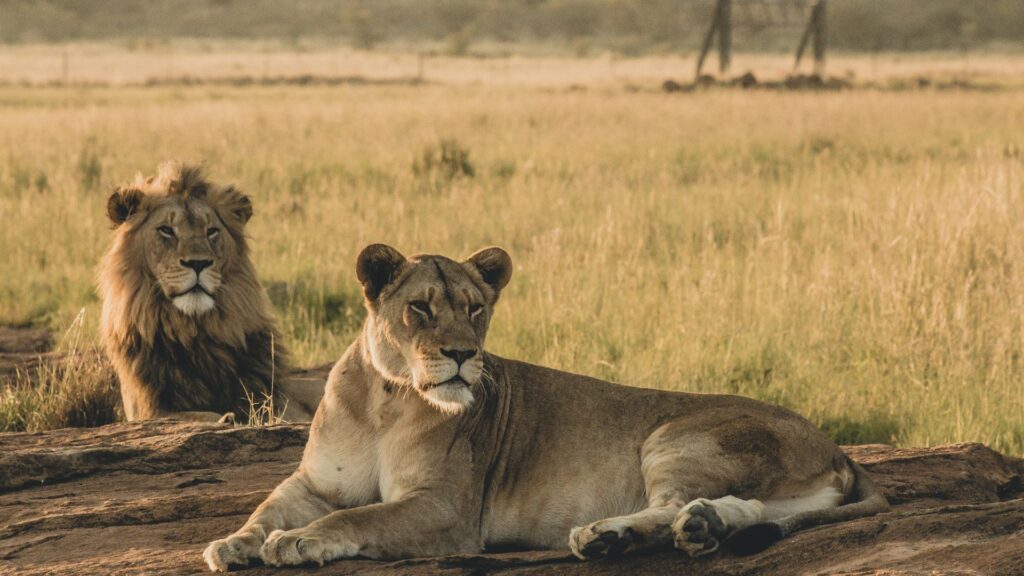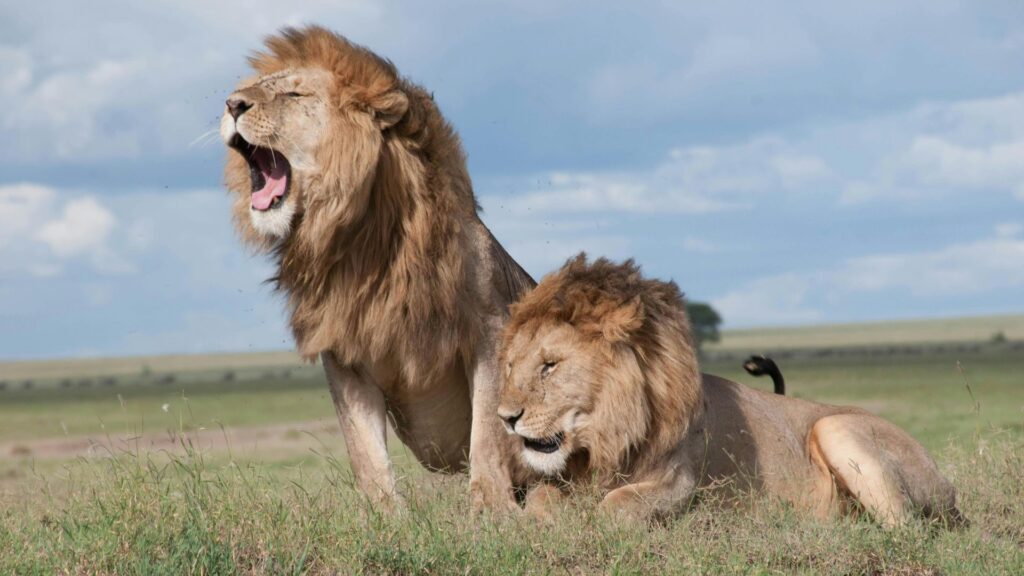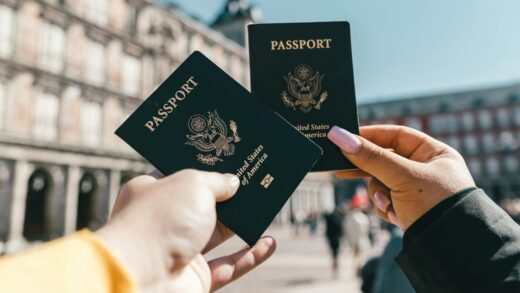The African lion, Panthera leo, stands as a symbol of strength, grace, and wild beauty amidst the vast savannas and grasslands of Africa. These majestic creatures, with their tawny coats and impressive manes (in males), evoke a sense of awe and reverence among both locals and visitors to the continent. Yet, beyond their striking appearance lies a complex and fascinating array of behaviors, social dynamics, and conservation challenges.
African lions are not solitary hunters but rather form intricate social structures known as prides, consisting of related females, their offspring, and a coalition of males. Within these prides, lions exhibit cooperative hunting strategies, relying on teamwork and coordination to take down large prey such as wildebeest or buffalo. Their vocalizations, ranging from deep roars to softer grunts, serve as vital forms of communication, facilitating bonding within the pride and marking territories against intruders.
However, despite their iconic status, African lions face a myriad of threats to their survival. Habitat loss, driven by human expansion and agricultural development, encroaches upon their traditional ranges, fragmenting their populations and diminishing their available prey. Human-wildlife conflict escalates as lions come into contact with livestock and communities, leading to retaliatory killings and further exacerbating conservation challenges. Additionally, poaching for traditional medicine and trophy hunting further imperils already vulnerable lion populations.
Despite these challenges, there is hope for the future of African lions. Conservation efforts, spearheaded by dedicated organizations and local communities, work tirelessly to mitigate human-lion conflicts, protect vital habitats, and raise awareness about the importance of lion conservation. By implementing sustainable land management practices, promoting coexistence between humans and wildlife, and supporting initiatives aimed at reducing illegal hunting and trade, we can ensure that future generations continue to marvel at the beauty and resilience of Africa’s iconic lions.
Facts About Lions in Africa:
These efforts extend beyond mere preservation; they encompass the broader ecosystem health and cultural heritage intertwined with lion conservation. African lions are not solitary entities but integral components of their ecosystems, playing crucial roles in maintaining ecological balance by regulating prey populations and shaping landscape dynamics. Moreover, they hold immense cultural significance for many African communities, featuring prominently in local folklore, rituals, and traditional beliefs.
As we navigate the complex landscape of lion conservation, it is imperative to recognize the interconnectedness of human and wildlife well-being. By fostering sustainable livelihoods for local communities, promoting responsible tourism practices, and empowering individuals to become stewards of their natural heritage, we can forge a path towards harmonious coexistence between humans and lions. This journey demands collaboration, innovation, and unwavering commitment from individuals, governments, and organizations alike.
In the face of mounting challenges, the future of African lions hangs in the balance. Yet, amidst the uncertainty, there remains a glimmer of hope—a collective determination to safeguard these magnificent creatures and the landscapes they call home. By embracing our shared responsibility to protect and conserve Africa’s lions, we not only ensure their survival but also reaffirm our commitment to preserving the rich tapestry of life that defines our planet.
Table of Contents About Facts About Lions in Africa
Introduction to African Lions

African lions, known scientifically as Panthera leo, stand as formidable symbols of the continent’s wild landscapes. These majestic creatures epitomize strength, grace, and adaptability, embodying the essence of Africa’s untamed beauty. Roaming the vast savannas, grasslands, and woodlands of sub-Saharan Africa, they command attention with their muscular build, golden fur, and striking manes that adorn the males. But beyond their physical allure, African lions represent an integral part of their ecosystems, playing a crucial role as apex predators.
Their presence not only regulates prey populations but also shapes the dynamics of the African wilderness. Yet, their existence is not without challenges. Human encroachment, habitat loss, and poaching threaten their survival, underscoring the urgent need for conservation efforts. Despite these adversities, African lions endure as resilient symbols of wilderness, captivating the hearts and imaginations of people worldwide. Their story is one of resilience, adaptation, and the delicate balance between humanity and the natural world.
Characteristics of African lions
African lions possess a remarkable array of characteristics that make them one of the most iconic and awe-inspiring creatures on the planet. Physically, they are formidable predators, boasting muscular bodies and sharp claws designed for hunting and taking down prey. Their tawny fur provides excellent camouflage in the savanna grasslands where they predominantly reside, allowing them to blend seamlessly into their surroundings as they stalk their prey. One of the most distinguishing features of male African lions is their majestic mane, which not only serves as a symbol of strength and dominance but also offers protection during fights with rival males.
This sexual dimorphism, where males exhibit prominent manes while females do not, is unique to lions among the big cat species. Beyond their physical attributes, African lions are also highly social animals, forming intricate family units known as prides. These prides typically consist of related females and their offspring, along with a coalition of males who defend the pride’s territory and mating rights. Within the pride, each member plays a specific role, contributing to the collective survival and success of the group. Lions are known for their cooperative hunting behavior, often working together to take down large prey such as wildebeests and zebras.
Communication is key within the pride, with lions using a variety of vocalizations, including roars, grunts, and growls, to convey messages and maintain social cohesion. Overall, the characteristics of African lions reflect their adaptability, strength, and intricate social structures, making them a fascinating subject of study and admiration in the animal kingdom.
Habitat and Distribution
The habitat and distribution of African lions are intricately linked to the vast and diverse landscapes of sub-Saharan Africa. These majestic predators predominantly inhabit the savannas, grasslands, and open woodlands of the continent, where they roam freely across expansive territories. Their adaptability allows them to thrive in various ecosystems, from the arid plains of the Serengeti to the dense bushlands of Kruger National Park. However, with human encroachment and habitat fragmentation on the rise, the once wide-ranging territories of lions are increasingly under threat. Deforestation, agricultural expansion, and urbanization encroach upon their habitats, leading to habitat loss and fragmentation.
This not only disrupts the natural balance of ecosystems but also increases the likelihood of human-wildlife conflicts as lions are forced into closer proximity with human settlements. Despite these challenges, efforts are underway to conserve and protect lion habitats through initiatives such as the establishment of protected areas and corridors, community-based conservation programs, and sustainable land management practices. By preserving their habitats and ensuring connectivity between fragmented areas, we can safeguard the future of African lions and the rich biodiversity they represent.
Physical Characteristics
African lions boast a remarkable array of physical characteristics that make them one of the most iconic and awe-inspiring species on the continent. Their muscular build and sleek, tawny fur not only contribute to their majestic appearance but also serve vital functions in their survival. Males are especially distinguished by their impressive manes, which vary in color and fullness depending on factors like age, genetics, and environmental conditions.
These manes not only serve as a symbol of dominance but also offer protection during fights with rival males, shielding the neck and throat from potential injuries. Additionally, lions are equipped with sharp claws and powerful jaws, enabling them to efficiently capture and subdue prey. Their teeth, specifically designed for tearing through flesh, are well-suited for their carnivorous diet, which primarily consists of large mammals such as zebras, wildebeests, and buffalo. Furthermore, lions exhibit sexual dimorphism, with males being significantly larger and heavier than females.
This dimorphism is further emphasized by the presence of the mane in males, adding to their imposing stature. Overall, the physical characteristics of African lions not only contribute to their visual splendor but also play essential roles in their survival and dominance within their ecosystems.
Behavior and Social Structure
The behavior and social structure of African lions are captivating aspects of their biology, reflecting their intricate dynamics and cooperative nature. Lions are highly social animals, forming cohesive groups known as prides. These prides typically consist of related females, their offspring, and a coalition of males. Within the pride, each member plays a distinct role, contributing to the survival and well-being of the group. Females are primarily responsible for hunting, employing coordinated strategies to bring down prey efficiently. Meanwhile, males defend the pride’s territory from intruders and rival males, ensuring the safety of the group and the continuity of their genetic lineage.
Communication is vital within lion prides, facilitated through various vocalizations such as roars, grunts, and growls. These vocal cues serve multiple purposes, including establishing territory, coordinating hunts, and maintaining social cohesion within the pride. The iconic roar of a lion, often heard echoing across the savanna, functions as a powerful territorial display, signaling strength and dominance to neighboring prides and potential intruders.
Lions exhibit remarkable cooperation and altruism within their social structure. They form strong bonds with pride members, engaging in grooming rituals and affectionate behaviors that reinforce social bonds. Cubs, in particular, receive extensive care and protection from the pride, with females collectively nursing and nurturing the young.
However, lion social dynamics are not without conflict. Intraspecific competition, especially among males vying for dominance and access to mates, can lead to aggressive encounters within prides or between rival coalitions. Such conflicts play a crucial role in shaping the hierarchical structure of lion societies and maintaining balance within ecosystems.
Overall, the behavior and social structure of African lions exemplify the complexities of group living among apex predators. By delving into these fascinating aspects of lion biology, we gain a deeper appreciation for their role in the African savanna and the importance of conserving their habitats and social networks for future generations to witness and admire.
Conservation Status
The conservation status of African lions is a matter of grave concern. Once widespread across the African continent, lion populations have significantly declined over the past century. Habitat loss, driven by human activities such as agriculture, urbanization, and infrastructure development, poses a severe threat to lion populations. Additionally, human-wildlife conflict exacerbates the situation, as retaliatory killings by livestock farmers and trophy hunting further diminish lion numbers. Poaching, both for traditional medicine and illegal wildlife trade, also contributes to the decline of lion populations, with their bones and body parts highly sought after.
Fragmentation of lion habitats due to human encroachment further exacerbates the challenges faced by these magnificent creatures. Despite these threats, concerted conservation efforts are underway to protect African lions. Various organizations and governments collaborate on initiatives such as habitat preservation, anti-poaching patrols, community-based conservation projects, and raising awareness about the importance of lion conservation. Conservationists work tirelessly to mitigate human-lion conflicts through methods like building predator-proof enclosures for livestock and implementing community education programs.
However, the road to lion conservation is fraught with challenges, requiring sustained commitment and cooperation from local communities, governments, conservation organizations, and the international community. It is imperative that we prioritize the conservation of African lions to ensure their survival for future generations and maintain the integrity of Africa’s ecosystems.
Human-Lion Conflict
Human-lion conflict is a complex and pressing issue that arises from the overlapping territories of humans and these apex predators. As human populations expand and encroach upon lion habitats, interactions between people and lions become inevitable, often leading to conflict. The root causes of human-lion conflict are multifaceted, including habitat loss, depletion of prey species, retaliatory killings, livestock depredation, and the perceived threat to human safety.
Lions, being territorial animals, may attack livestock or even humans when their natural prey is scarce or when they feel threatened. In retaliation, farmers may resort to killing lions to protect their livelihoods and ensure their safety, further exacerbating the conflict. Moreover, habitat fragmentation due to human activities leads to isolated lion populations, increasing competition for resources and exacerbating conflicts between lions and humans.
Addressing human-lion conflict requires a holistic approach that considers the needs of both communities and wildlife. Conservation organizations and governments implement various strategies to mitigate conflict, such as deploying trained teams to respond to conflict incidents, establishing predator-proof enclosures for livestock, promoting community-based conservation initiatives, and providing compensation for livestock losses.
Furthermore, raising awareness and fostering coexistence between local communities and lions are essential components of conflict resolution. Education programs can help communities understand lion behavior and implement measures to minimize conflicts, such as using deterrents like lights and sound to ward off lions from livestock enclosures. Additionally, promoting sustainable land-use practices and implementing zoning plans that designate areas for human settlement away from critical lion habitats can help reduce conflict in the long term.
Ultimately, effective management of human-lion conflict requires collaboration between stakeholders, including local communities, conservationists, government agencies, and NGOs. By addressing the underlying causes of conflict and promoting coexistence, we can strive towards a future where humans and lions can peacefully share the landscape.
African lion pride dynamics

The dynamics within an African lion pride are complex and fascinating, revealing a tightly knit social structure crucial for survival in the wild. At the heart of a pride lies a group of related lionesses, typically led by an alpha female, who collaboratively hunt, care for their young, and defend their territory. These lionesses form the backbone of the pride, displaying remarkable cooperation and coordination during hunts, often employing strategic tactics to take down large prey.
Alongside them are the pride’s cubs, the future generation of hunters, who are nurtured and protected within the safety of the group. Complementing the female contingent are the dominant males, forming coalitions that guard the pride’s territory and provide protection against rival males and potential threats.
The intricate social hierarchy within a pride is maintained through a combination of vocalizations, body language, and occasional displays of dominance. Alpha females assert their authority over the group, ensuring cohesion and discipline among the members. Meanwhile, male coalitions establish their dominance through physical prowess and strategic alliances, vying for control over territories rich in resources such as prey and water sources.
However, pride dynamics are not without their tensions and challenges. Rivalries may emerge between individuals vying for dominance or resources, leading to conflicts within the pride. In some cases, internal strife can result in the expulsion of individuals from the group, particularly young males seeking to establish their own territories or challenge existing leaders.
Despite these occasional conflicts, the bonds forged within a pride are remarkably resilient, fostering cooperation and mutual dependence among its members. Together, they navigate the challenges of their environment, from securing food to defending against predators, embodying the strength and resilience of Africa’s iconic apex predators. Understanding the intricacies of African lion pride dynamics offers valuable insights into the complexities of wildlife social behavior and underscores the importance of preserving their natural habitats for generations to come.
Summary of Key Points
In summary, African lions are awe-inspiring creatures that epitomize the wild beauty of the African savannas. Their habitat spans across the vast expanses of sub-Saharan Africa, where they reign as apex predators, commanding both respect and admiration. With their muscular build, tawny fur, and majestic manes in males, African lions embody strength and regality.
Yet, beyond their physical prowess, lions exhibit complex social behaviors, forming tight-knit prides led by dominant males and consisting of related females and their offspring. Within these prides, lions showcase remarkable cooperative hunting tactics and communicate through a rich array of vocalizations, illustrating their sophisticated social structures.
However, alongside their magnificence, African lions face formidable challenges to their survival. Human activities such as habitat destruction, encroachment, and poaching threaten their existence. As human populations expand and habitats diminish, conflicts between humans and lions escalate, leading to tragic consequences for both parties.
Conservation efforts play a pivotal role in safeguarding these iconic animals, aiming to address the root causes of conflict, protect their habitats, and combat illegal poaching. By raising awareness, supporting conservation initiatives, and promoting coexistence between humans and lions, we can secure a brighter future for these magnificent creatures and ensure that they continue to roam the African plains for generations to come.
FAQs About Facts About Lions in Africa:
- Do lions only live in Africa?
- Yes, lions are native to Africa and are not found in the wild outside of the continent, except for a small population of Asiatic lions in India’s Gir Forest.
- How fast can a lion run?
- Lions can reach speeds of up to 50 miles per hour in short bursts, making them formidable predators when hunting.
- Are lions endangered?
- Yes, lions are classified as “vulnerable” by the International Union for Conservation of Nature (IUCN), with populations declining due to habitat loss, poaching, and human-wildlife conflict.
- What is a group of lions called?
- A group of lions is called a pride, which typically consists of related females, their offspring, and a coalition of one to several male lions.
- How long do lions live in the wild?
- Lions in the wild typically live for 10 to 14 years, although individuals in captivity can live longer, sometimes up to 20 years.
Thank you, if you liked this information of mine then do give feedback. Your feedback will motivate me further so that I can give you more information.




